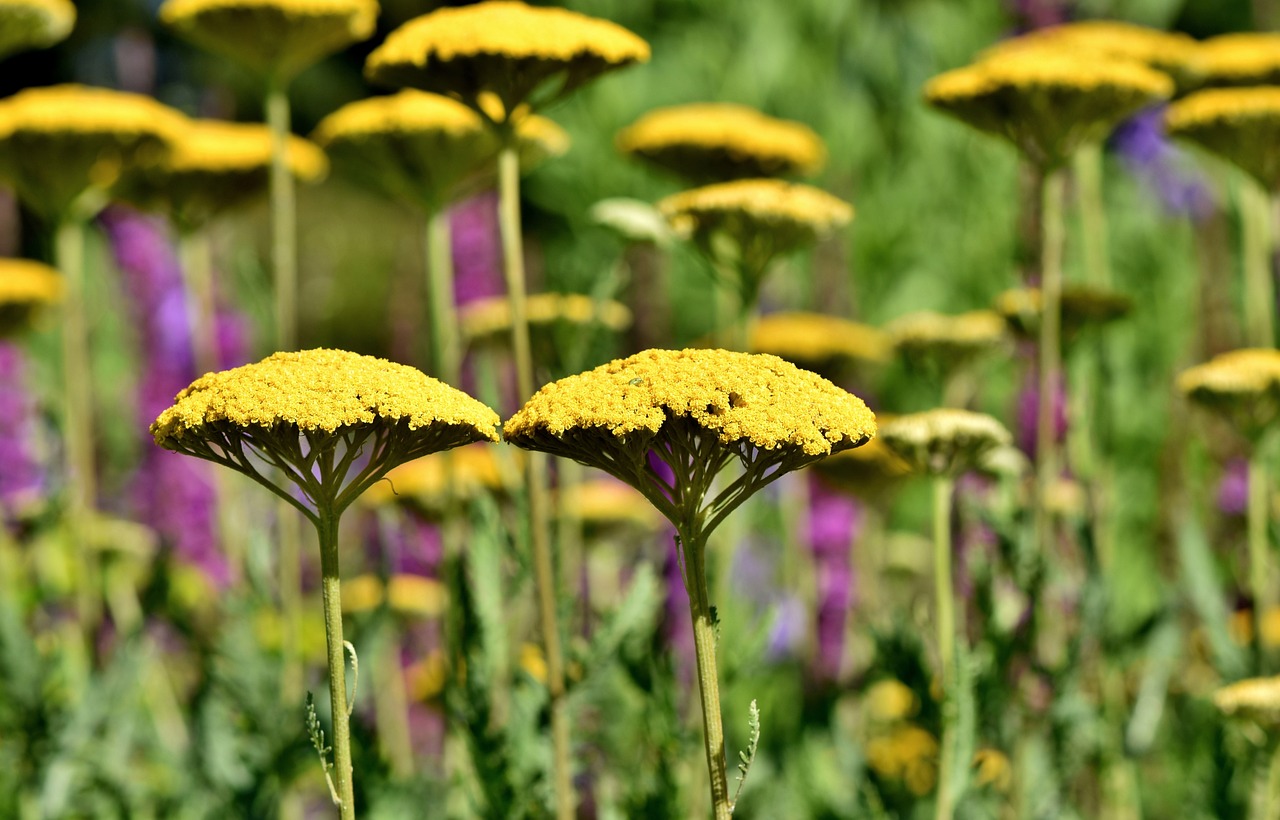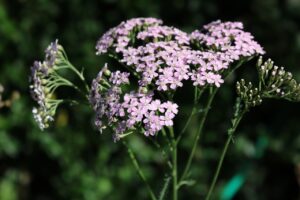Yarrow
Overview
The Achillea millefolium, or yarrow, is a perennial with delicate, white flowers and a strong fragrance. Often associated with healing, this versatile plant is known for its potential to soothe skin, aid digestion, and reduce inflammation due to its rich blend of beneficial compounds. While commonly used in traditional medicine, the practice of smoking yarrow is not widespread, and caution is advised due to possible health risks.
Common name(s): Common yarrow, milfoil, soldier's woundwort, thousand-leaf, nosebleed plant, old man's pepper
Scientific name: Achillea millefolium

Characteristics
Known for its small, clustered white flowers, feathery leaves, and traditional wound-healing properties.
Region
Yarrow is commonly found across Europe, North America, and Asia in a variety of habitats including fields, meadows, and coastal areas.
Natural Habitat
Commonly found in fields, meadows, and along roadsides.
Cultivation
Prefers full sun, well-drained soil, and requires moderate to low watering.
Traditional Usage
Yarrow has been held in high regard for its medicinal properties across different cultures throughout history. Its traditional uses focus predominantly on healing and pain management. Listed below are some of the notable traditional applications of yarrow:
- Wound treatment, as it’s credited with hemorrhagic and antiseptic qualities that help stop bleeding and cleanse wounds.
- Management of cold and flu symptoms, leveraging its purported anti-inflammatory effects to alleviate suffering.
- Aid in digestion, as yarrow is believed to have digestive tonic effects that improve gastrointestinal function.
- Relief for skin irritations, thanks to its soothing properties when used as a salve or poultice.
These uses manifest the deep-rooted belief in the healing power of plants and highlight yarrow’s esteemed place in traditional herbal medicine3.
Historical Usage
Used historically for wound healing, with applications noted among Neanderthals and in ancient Greek warfare.
Common Usage
Currently used for skin care, wound healing, digestion aid, and cold symptom relief.
Effects
Yarrow is a herb celebrated for its variety of uses both in historical contexts and in modern alternative medicine. While its use in smoking is not well-documented, the herb is popular for other traditional applications due to its numerous potential health benefits. Here are some general effects that have been attributed to yarrow:
- Soothing skin irritation: Yarrow is used topically to calm irritated skin and reduce inflammation.
- Promoting wound healing: Its astringent properties may help in the faster recovery of wounds.
- Anti-inflammatory effects: When applied to the skin, yarrow might lessen inflammation, assisting in the healing process.
- Aiding digestion: Ingesting yarrow is thought to contribute to better digestive health.
- Relief from cold and flu symptoms: It may help alleviate respiratory symptoms associated with the common cold and flu.
It’s essential to recognize that while these effects offer potential benefits, individual experiences may vary, and consulting a healthcare provider is always recommended before traditional or alternative remedies are used 3.

Versatile in its benefits, this plant offers topical relief for skin irritation and inflammation, accelerates wound healing, supports digestive health, and provides comfort from colds when consumed.
Effects when smoking
When yarrow is smoked, the experience and effects can be quite different from its use in other forms such as teas or topical applications. It’s important to note that the specific outcomes can vary from person to person, and its use by smoking is not commonly practiced or thoroughly studied, which means caution should be exercised.
The inhalation of yarrow smoke might provide a sort of aromatic therapy, as its pungent, bitter flavor suggests a strong presence of its active compounds. These compounds are thought to have various health properties, including anti-inflammatory benefits, which could potentially translate to some relief when smoking yarrow.
However, the lack of detailed studies on the effects of smoking yarrow leaves room for potential risks. One should be mindful of the possibility of respiratory irritation, as well as consider the general concerns associated with smoking plant material. It’s crucial to understand that smoking yarrow is not widely endorsed by the health community, and any potential benefits do not outweigh the risks of smoking, especially for individuals with preexisting respiratory issues.
For those still considering exploring yarrow in smoked form, it’s vital to consult with a healthcare provider first. This step ensures you can discuss any possible interactions with medications, allergies, and any specific health risks you may not have considered. Safety should always be the first priority when trying new herbal practices.
Flavor Profile
Pungent and bitter flavor profile.
Edible Parts
Leaves and flowers
Effects when Smoked
Effects when smoked are not well-documented and may pose health risks; cautious approach advised.
User Experiences
User experiences vary, with some noting improvements in skin and wound healing and others valuing its digestive and cold symptom relief properties.
Medicinal Benefits
Did you know that yarrow, a common herb found in nature, may offer a host of potential medicinal benefits? Let’s look at what makes this herb so special:
- Anti-inflammatory: Yarrow contains active compounds like flavonoids that might reduce inflammation, providing comfort for various conditions.
- Wound healing: Its reputation for promoting wound healing is well established, thanks to its astringent properties that can help control bleeding.
- Digestive aid: Traditionally, yarrow has been used to support digestive health, helping to soothe stomach discomfort.
- Cold and flu relief: With anti-septic qualities, yarrow is thought to offer relief from symptoms associated with colds and flu.
Remember, while the benefits of yarrow are promising, it’s wise to use this herb under the guidance of a healthcare professional to ensure safety and proper dosage1 3. Smoking yarrow is not conventional and should be approached with caution due to the lack of documented effects and potential respiratory risks.
History and Folklore
Yarrow has a storied past as a healing herb. Its properties are rooted in ancient practices, with Neanderthals utilizing it for wound care, a testament to its long-standing medicinal uses. The plant’s connection to historical figures like Achilles highlights its significance in battlefield medicine, earning it the moniker herba militaris. From these early applications, yarrow’s reputation as a versatile remedy has persisted through the ages.
Its legacy in traditional medicine underscores a deep-rooted respect for the plant’s therapeutic abilities. Whether applied directly to injuries or used to manage other ailments, yarrow’s historical use underscores its integral role in herbal lore and ancient healing practices.

Yarrow, with a rich history of healing, has been used since Neanderthal times for wound care and was renowned in ancient battlefield medicine.
Side Effects and Contraindications
When considering yarrow for home smoking, it’s crucial to be aware of the herb’s potential side effects and contraindications. Yarrow can cause allergic reactions, particularly in individuals sensitive to the Asteraceae family. Symptoms may include rash, dizziness, and breathing difficulties.
Additionally, due to its blood-thinning properties, yarrow should not be used by individuals with bleeding disorders or those taking anticoagulant medication. Pregnant women should avoid yarrow as it may induce menstruation and potentially cause miscarriage. High doses, whether smoked or ingested, can be toxic and may result in headaches, dizziness, or increased skin sensitivity to sunlight. Because of the lack of research on the effects of smoking yarrow, approaching this method with caution is advised1 3.
Legal Status
Legal Status of Yarrow
Yarrow is a legal substance in most areas and is readily available in health food stores as a herbal supplement. While this is the general status, always double-check your local laws and regulations to ensure compliance. Variations in legal status may occur based on regional policies.
References
1. Jeanine Vélez-Gavilán. “Achillea millefolium (yarrow) | CABI Compendium.” CABI. https://www.cabidigitallibrary.org/doi/10.1079/cabicompendium.2636
2. “Achillea millefolium – Wikipedia.” Wikipedia. https://en.wikipedia.org/wiki/Achillea_millefolium
3. “The Uses and Benefits of Yarrow | Gardener’s Path.” Gardener’s Path. https://gardenerspath.com/plants/herbs/yarrow-benefits-uses/
4. “Achillea millefolium – Plant Finder – Missouri Botanical Garden.” Missouri Botanical Garden. https://www.missouribotanicalgarden.org/PlantFinder/PlantFinderDetails.aspx?kempercode=b282
Image Credit: Ralphs_Fotos
Image Credit: Rollstein
Image Credit: vickypawprince
Nicolas Duval
Nicolas is a passionate advocate for nature and the art of wildcrafting. His dedication shines through in Wildcraftia, a website he meticulously crafted to serve as a haven for nature enthusiasts worldwide. Driven by a deep appreciation for nature’s connection to humanity, Nicolas embarked on his journey in 2011 with SmokableHerbs, a platform showcasing his love for nature’s bounty. Building upon this foundation, he established Smokably, a thriving online store offering premium herbs and blends to a global audience.
